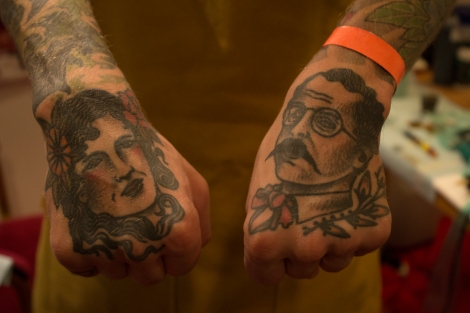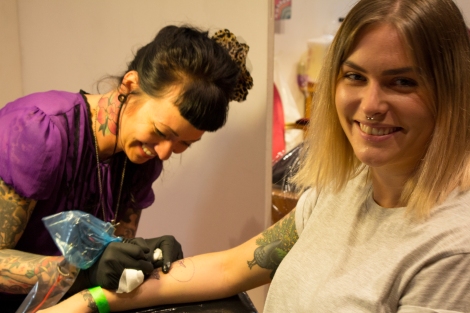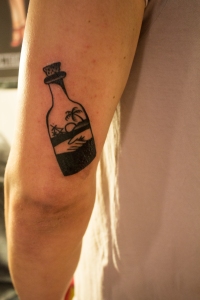by Alex Stolz
Wild bustling in the normally peaceful and quiet Kulturhuset: People impatiently wanting to enter the door, but the security guards stop them firmly to check their identity cards. No admission under 18! They are very strict on that point. Once, the first hurdle is taken, there is one more stop: the cash counter. Then finally the arty Saturday can begin – a Saturday filled with body art.
A small woman, dressed up in Rockabilly style, tries to find her way in the bustle. She checks on every booth, “Are you ok there? Do you need anything?” Jasmin Sundblad is one of the organizers of the second annual Pennybridge Tattoo Mess in Örebro, which took place last month. Where other people enjoy either observing the transformation of bodies, or go under the needle themselves, the 26-year-old makes sure that the estimated 2000 visitors and 35 tattoo artists from all over Sweden are having a good time.
To some it might come as a surprise that the small town of Örebro, with just approximately 130.000 inhabitants, is hosting such a tattoo convention. However, with a closer look, it is no wonder that Jasmin has quite a busy Saturday: Swedes are assumed to have the highest density of tattoos per person. Whereas decades ago, tattoos were still supposed to be worn by either criminals and sailors, or by wild individualists, who needed the ink under their skin as a form of self-expression. Tattoos are nowadays Normcore in the biggest Nordic country.
Official statistics are rare in the tattoo business. But according to a survey of the Stockholm Metro Magazine, 33 percent of the Swedish capital’s inhabitants between 18 and 49 use their skin as a canvas. It is assumed that 2000 Swedes get a tattoo daily. In comparison, only 14 percent of the people living in Germany between 25 and 54 have body art.
So why do Swedish people feel an increased appeal to add some art to their body? Jasmin has her very own explanation for that: “Worldwide, Sweden is number three in music exports. Both areas, the music business and tattoo art, affect each other.” But that would imply that tattoos are only for supporters of the sex, drugs and rock’n’roll lifestyle. After all, isn’t pop culture the determining factor nowadays?
Tattoos have a long tradition in history. Even the 1991 found glacier mummy, Ötzi, was wearing about 60 tattoos. With that, inking the body has a tradition of more than at least 5000 years. Other theories reveal that James Cook brought this special art to Europe from one of his expeditions to Tahiti. Originally, the word comes from Tahitian “ta”, which means drawing and “tu”, translated as soul. In the first place, indigenous peoples used tattoos as rituals in order to be accepted as part of a tribe.
For many years in modern western culture, tattoos had exactly the opposite meaning, to show that one is not part of the mainstream. But if nearly everyone has a tattoo meanwhile, the old feeling of belonging is reproduced. “It has become a norm, that’s true”, admits Jonatan “Jonte” Palm. The tattoo artist also hosts a booth at the Tattoo Mess. From his own experience of owning a tattoo studio in Stockholm he tells, “but every Tattoo is unique, so there is still the very individual side.”
Also Pontus Zetterlund wants to add some individualism to his body. At the Tattoo Mess, he lets Jonte plunge the needle into his upper arm. While clenching his teeth, the psychology student whispers: “Sweden is an open and diverse society. We accept people the way they are. Probably that’s why it’s so popular here.” Individualism, just because it’s accepted. Sounds like a logical explanation. However, law student Cibelle Broman sees a different reason: “Swedish culture is very lagom – don’t go to extremes. The government takes care of a lot in our daily lives.” In her opinion, tattoos are an expression of a breakout of the regular, while it still fits into the concept of lagom, as it does not threaten Swedish society.
Australian Alice Edwards is counted among those that are getting a tattoo at the convention as well. An eagle, “just because I liked it.” When she came to Sweden, she was surprised to see many people with tattoos. In her home country, people with tattoos often experience
stigmatization, as the black ink is still considered to be most popular among biker gangs. Also, she admits, “Australia is quite a conservative country, while Sweden is more liberal.” According to an Australian market research institute, only 12 percent of the whole population have a tattoo. So possibly, the system of the government is a determining factor over to which extent individualism can be expressed.
Later in the day, Jasmin makes another round to check on everyone. “What a long day”, she sighs. The first visitors are heading home. Some of them with a fresh piece of art on their body, some of them just with the images in their head. Whatever it is, that makes Swedish people feeling more attracted to tattoos than other nations, the arty Saturday is nearly over. Normcore has it that Monday work starts again. The Kulturhuset will lay in its quiet and peaceful atmosphere once again.



